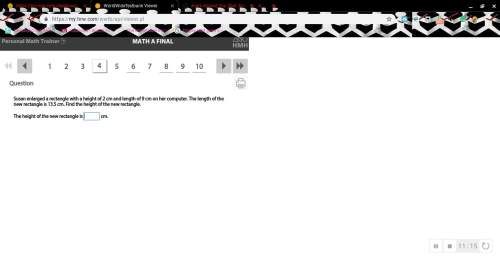
Mathematics, 26.01.2020 17:31 jessnolonger
Claudia had a rope that was 12 feet long. she cut it into 24 equal lengths. how long in inches is each new rope

Answers: 2
Another question on Mathematics

Mathematics, 21.06.2019 16:30
Jorge planted flowers in his garden he planted one row of 12 tulips and one row of 36 daisies george's friend kylie has a garden with 75 flowers in it kylie's garden only contains tulips and daisies. is it possible for kylie‘s garden she have the same ratio of tulips to daisies as george's garden?
Answers: 1

Mathematics, 21.06.2019 19:20
Is the product of two rational numbers irrational or rational? first, make a hypothesis by multiplying two rational numbers. then, use variables such as x=a/b and y=c/d and the closure property of integers to prove your hypothesis.
Answers: 1

Mathematics, 21.06.2019 23:30
Find the directions in which the function increases and decreases most rapidly at upper p 0p0. then find the derivatives of the function in these directions. f(x,y)equals=x squared plus xy plus y squaredx2+xy+y2, upper p 0p0left parenthesis 1 comma negative 4 right parenthesis
Answers: 2

Mathematics, 22.06.2019 02:00
Study published in the journal of personality and individual differences found that adults with adhd displayed more creative achievement than those who didn't have the disorder. "for the same reason that adhd might create problems, like distraction, it can also allow an openness to new ideas," says holly white, assistant professor of cognitive psychology. "not being completely focused on a task lets the mind make associations that might not have happened otherwise." white and priti shah at the university of michigan gave 60 college students – half of them with adhd – a series of tests measuring creativity across 10 domains. the adhd group scored higher across the board. the adhd group showed more of a preference for brainstorming and generating ideas than the non-adhd group, which preferred refining and clarifying ideas. the adhd status of the participants was established by asking whether the individual had ever been clinically diagnosed with adhd/add. the tests of creativity were pencil-and-paper tasks administered in a laboratory setting. each of the ten scales was comprised of multiple questions, the scores on which were summed (e.g., writing creativity: "how many words can you make from the letters in the word 'psychology' invention creativity: "write down as many uses for a paper clip that you can think of.") this procedure does allow for a participant to be scored as showing no creativity under these conditions. a) state the research question in plain language (i wonder if is related to (1 point) b) state the null hypothesis (1 point) c) state the research hypothesis (1 point) d) is the research hypothesis directional or non-directional (1 point) e) name the predictor / independent variable f) give the operational definition of the predictor / independent variable g) evaluate the construct validity of the predictor / independent variable. (face, procedure, method-match) h) name the outcome / dependent variable i) give the operational definition of the outcome / dependent variable. j) evaluate the construct validity of the outcome / dependent variable. (face, procedure, method-match)
Answers: 1
You know the right answer?
Claudia had a rope that was 12 feet long. she cut it into 24 equal lengths. how long in inches is ea...
Questions

Mathematics, 20.07.2019 21:30

Social Studies, 20.07.2019 21:30





History, 20.07.2019 21:30

Arts, 20.07.2019 21:30



Mathematics, 20.07.2019 21:30


Mathematics, 20.07.2019 21:30










